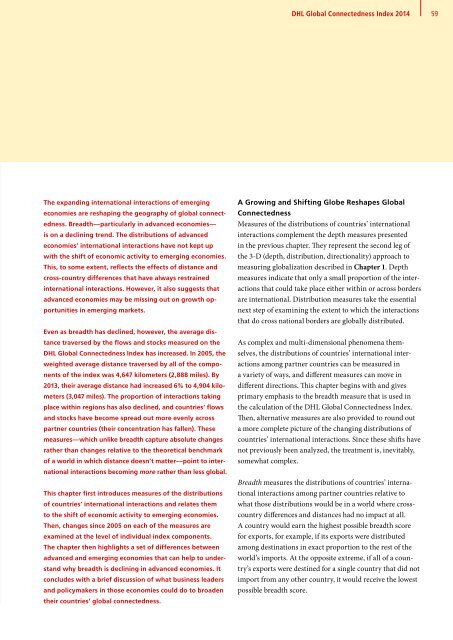DHL Global Connectedness Index 2014
DHL Global Connectedness Index 2014
DHL Global Connectedness Index 2014
- No tags were found...
You also want an ePaper? Increase the reach of your titles
YUMPU automatically turns print PDFs into web optimized ePapers that Google loves.
<strong>DHL</strong> <strong>Global</strong> <strong>Connectedness</strong> <strong>Index</strong> <strong>2014</strong><br />
59<br />
The expanding international interactions of emerging<br />
economies are reshaping the geography of global connectedness.<br />
Breadth—particularly in advanced economies—<br />
is on a declining trend. The distributions of advanced<br />
economies’ international interactions have not kept up<br />
with the shift of economic activity to emerging economies.<br />
This, to some extent, reflects the effects of distance and<br />
cross-country differences that have always restrained<br />
international interactions. However, it also suggests that<br />
advanced economies may be missing out on growth opportunities<br />
in emerging markets.<br />
Even as breadth has declined, however, the average distance<br />
traversed by the flows and stocks measured on the<br />
<strong>DHL</strong> <strong>Global</strong> <strong>Connectedness</strong> <strong>Index</strong> has increased. In 2005, the<br />
weighted average distance traversed by all of the components<br />
of the index was 4,647 kilometers (2,888 miles). By<br />
2013, their average distance had increased 6% to 4,904 kilometers<br />
(3,047 miles). The proportion of interactions taking<br />
place within regions has also declined, and countries’ flows<br />
and stocks have become spread out more evenly across<br />
partner countries (their concentration has fallen). These<br />
measures—which unlike breadth capture absolute changes<br />
rather than changes relative to the theoretical benchmark<br />
of a world in which distance doesn’t matter—point to international<br />
interactions becoming more rather than less global.<br />
This chapter first introduces measures of the distributions<br />
of countries’ international interactions and relates them<br />
to the shift of economic activity to emerging economies.<br />
Then, changes since 2005 on each of the measures are<br />
examined at the level of individual index components.<br />
The chapter then highlights a set of differences between<br />
advanced and emerging economies that can help to understand<br />
why breadth is declining in advanced economies. It<br />
concludes with a brief discussion of what business leaders<br />
and policymakers in those economies could do to broaden<br />
their countries’ global connectedness.<br />
A Growing and Shifting Globe Reshapes <strong>Global</strong><br />
<strong>Connectedness</strong><br />
Measures of the distributions of countries’ international<br />
interactions complement the depth measures presented<br />
in the previous chapter. They represent the second leg of<br />
the 3-D (depth, distribution, directionality) approach to<br />
measuring globalization described in Chapter 1. Depth<br />
measures indicate that only a small proportion of the interactions<br />
that could take place either within or across borders<br />
are international. Distribution measures take the essential<br />
next step of examining the extent to which the interactions<br />
that do cross national borders are globally distributed.<br />
As complex and multi-dimensional phenomena themselves,<br />
the distributions of countries’ international interactions<br />
among partner countries can be measured in<br />
a variety of ways, and different measures can move in<br />
different directions. This chapter begins with and gives<br />
primary emphasis to the breadth measure that is used in<br />
the calculation of the <strong>DHL</strong> <strong>Global</strong> <strong>Connectedness</strong> <strong>Index</strong>.<br />
Then, alternative measures are also provided to round out<br />
a more complete picture of the changing distributions of<br />
countries’ international interactions. Since these shifts have<br />
not previously been analyzed, the treatment is, inevitably,<br />
somewhat complex.<br />
Breadth measures the distributions of countries’ international<br />
interactions among partner countries relative to<br />
what those distributions would be in a world where crosscountry<br />
differences and distances had no impact at all.<br />
A country would earn the highest possible breadth score<br />
for exports, for example, if its exports were distributed<br />
among destinations in exact proportion to the rest of the<br />
world’s imports. At the opposite extreme, if all of a country’s<br />
exports were destined for a single country that did not<br />
import from any other country, it would receive the lowest<br />
possible breadth score.





